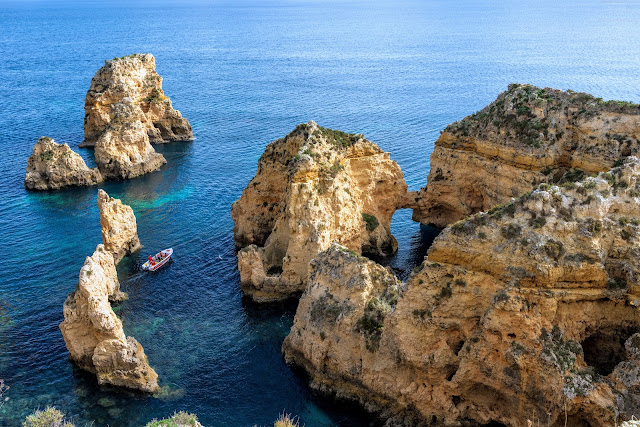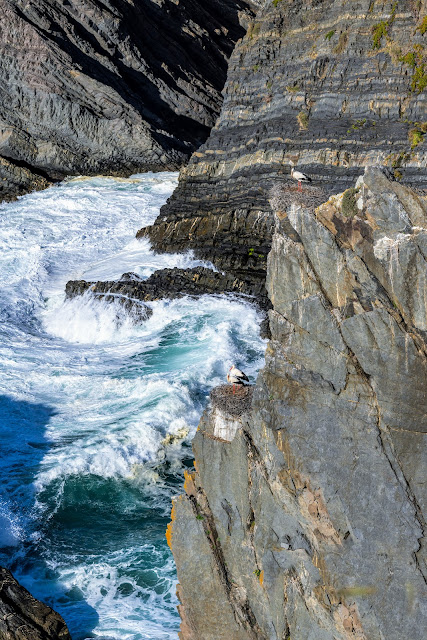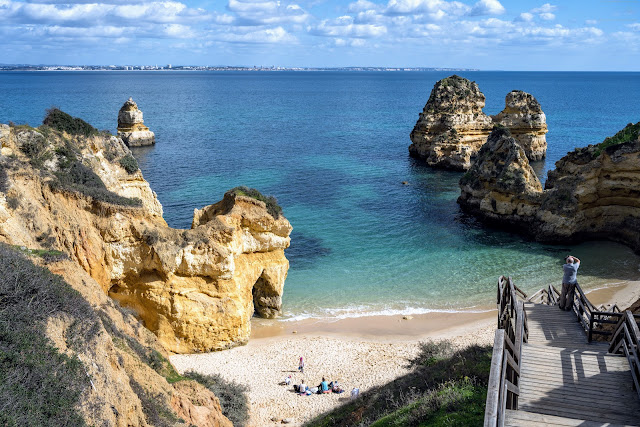According to Wikipedia "Cape Saint Vincent is a headland in the municipality of Vila do Bispo, in the Algarve, southern Portugal. It is the south-westernmost point of Portugal and of mainland Europe”. Hundreds of years ago (when the planet was presumed flat), they probably called it “The end of the world” as there was nothing beyond that point but the sea - until it fell into an endless abyss where it reached its end. In Madrid, we did not have to worry about falling into any sea abyss by accident, Cape St. Vincent is 900 Kms from Madrid. Now that the planet is not flat anymore and there is no abyss, a trip to the Cape is in order. It is a bit far, but worth the distance if we are to see such landscapes.
The Algarve, with its rocky coastline and beautiful sandy beaches is actually the biggest tourist destination in Portugal; still, it is quite peaceful in winter. The west coast is an open Atlantic sea with wonderful and isolated beaches, the south coast is as picturesque as the West, with segments of multiple tourist development projects. It is also the home of thousands of Retirees, ex-UN staff members included. These are landscapes created by huge storms, strong winds and gigantic waves (the World surf championships take place in beaches further north near Lisbon). Geological sedimentary formations that include fossils in certain areas provide images that are like works of art.
This sampling of pictures was taken in different places over a period of several days in which we travelled through the South and West Coast.
 |
Window
|
The three images above were taken in Joao de Arens Beach, near Portimao in the South, some 70 Km East from Cape St Vincent
.
 |
| Cape St. Vincent |
 |
| Waves |
 |
| Waves |
The waves are from a beach around Carrapateira, some 30 Kms North of the Cape in the West Coast.
 |
| Rocks & Boat |
The two pictures above were taken in Ponta da Piedade, near Lagos, South coast, where you can also find a beautiful Lighthouse (and Radar).
 |
| Beach |
 |
| Sunset |
The above two images are from a beach by the village of Vila Nova de Milfontes (West Coast).
 |
| Art |
 |
| Art |
Storks, in their migrations, stopped by for centuries - until they also decided to stay permanently, even if they are not retired! In some places, they inhabit any elevated point by the sea; one wonders how they can feel secure with the roar of the waves at their feet and the very strong winds continuously threatening their huge nests. It is amazing how they have adapted to the extreme conditions and have even developed a flying technique I have not seen elsewhere, similar to that used by vultures: they jump off the nest, open their wings and let themselves be taken by the wind with no apparent effort.
 |
| Storks |
 |
| Storks |
The storks live in Cabo Sardao, further up North on the West Coast.
 |
| Beach |
 |
| Art |
The four pictures above are from Carriagem beach, North of Carrapateira, also on the West Coast, taken on different days.
Whatever the purpose of your trip, tourism, permanent residency or photography, the Algarve will not disappoint you. Just time your trip so you can avoid the crowds.
It was difficult making this selection from the hundreds of pictures I took. The trip continued to Nazaret (North of Lisbon) where you have the Surf World Championships, and then to two beautiful monasteries in Portugal on the way back to Madrid that are also a must. Portugal is indeed a beautiful country.


















Comments
Post a Comment
If you are a member of XUNICEF, you can comment directly on a post. Or, send your comments to us at xunicef.news.views@gmail.com and we will publish them for you.